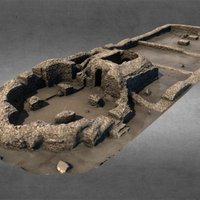Ostrów Lednicki - Zabytek.pl
Ostrów Lednicki
Address
Rybitwy
Location
voivodeship wielkopolskie,
county gnieźnieński,
commune Łubowo
It was probably here that the baptism of Mieszko I and his entourage took place, and here that Boleslaus the Brave entertained Emperor Otto III during his pilgrimage to the grave of St Adalbert in Gniezno in the year 1000.
The earliest settlements in this region date back to the turn of the 5th millennium bc; however, it was not until the 7th and 8th centuries that the first ones of any significance began to appear around the lake. A stronghold featuring large houses (probably a centre of tribal power) was built on a northern elevation. Having burnt down in the 9th century it was rebuilt in the early 10th century and enclosed by an earth-and-timber rampart.
Half a century later Mieszko I founded a large new defended stronghold on the same site, protected by a huge rampart, c. 500 m long and up to 8 m high (originally it may even have had a height of 12 m). Stone buildings (possibly the first in Poland) were raised within these fortifications. The site, littered with ruins since time immemorial, first caught the attention of travellers in 1822, though it was actually ‘discovered’ and fervently popularised by Count Edward Raczyński, who made a huge contribution to the salvage of national monuments. He forced historians (Count Aleksander Przeździecki and Marian Sokołowski among them) to take a closer look at this site, which was awaiting its return to the national consciousness - a place shrouded in mystery and terror according to local reports. The treasures of which local legends told proved to be the relict walls peering out from the grass - the extant remains of a group of pre-Romanesque ecclesiastical and residential buildings.
There was a rectangular palace measuring 32 × 14 m, with a grand hall at its western end, probably located on the first floor. Rumour has it that this was where Boleslaus, son of Mieszko I and his wife Dobrava, was born. The chapel (almost 11.5 m in diameter) abutting the ducal residence featured four apses forming a Greek cross in layout. The east end of the chapel terminated in an apse for the altar. The lower storey survives in the form a vaulted crypt connected to the chapel. Its outer walls were faced with evenly hewn, typically Romanesque blocks of stone. The complex is reminiscent of the best examples of Ottonian palaces in Germany. Thus, it has been hypothesised that the group of buildings in Ostrów Lednicki was raised prior to ad 966 ahead of the planned baptism of Mieszko I - a theory supported by the discovery of two baptismal basins. Two accompanying rooms were probably associated with these basins - a disrobing room and a place where rites preceding baptism (i.e. renunciation of the devil and profession of faith) took place. Scholars believe that this is currently the only known example north of the Alps of a baptistery dating from the latter 10th century, hence from the earliest days of Poland’s Christianisation.
Several dozen metres further north archaeologists uncovered the remains of a small, aisleless, stone church, interpreted as a sepulchral church or missionary cathedral of the Poznań bishopric. Evidence of burials discovered inside was thought to represent the final resting place of Boleslaus the Brave’s sons. Thus, the church can be regarded as one of the earliest ducal burial grounds in Poland.
The stronghold was linked to the mainland by two wooden bridges: one measuring c. 180 m long, the other - 420 m. A number of subsidiary service settlements grew up in the vicinity of the bridges. Archaeological excavations led to the discovery of numerous moveable finds. Most notable are the devotional artefacts, which include a cruciform reliquary with semicircular ends. The residents of Ostrów left gold and silver accessories behind them, as well as items of everyday use and coins from around the world. The most significant assemblage is of military equipment encompassing almost 300 items of arms and armour. These include chain mail, a helmet with nose-piece made from a single piece of iron, swords, spearheads inlaid with silver and copper, battleaxes, and stirrups embellished with geometric motifs. Only the wealthiest of warriors could afford such ornate and expensive equipment.
Ostrów’s heyday was brought to an end in 1038 when the armies of Bretislaus, Duke of Bohemia, launched a devastating raid on Greater Poland. After the stronghold had been rebuilt it became the seat of a local castellany. It survived until the mid-12th century, but once abandoned it was converted into a cemetery.
Category: archaeological monument
Protection: Historical Monument
Inspire id: PL.1.9.ZIPOZ.NID_N_30_PH.8413
